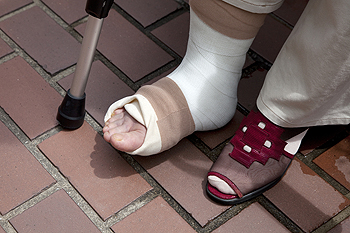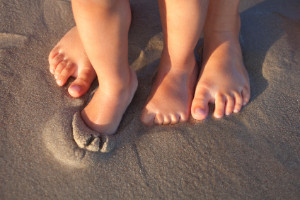 The most common cause of heel pain may be a condition that is referred to as plantar fasciitis. It occurs when the thick ligament that connects the heel to the front of the foot becomes inflamed. It’s purpose is to aid in walking, in addition to supporting the arch. Some of the symptoms that many patients experience is heel pain and moderate to severe stiffness, which may make walking up and down the steps difficult. This condition may affect people from all walks of life, and more specifically runners, women in late pregnancy, and those who are overweight. Additionally, this ailment may be caused by inherited traits, which may play a role in altering the structure of the foot. If you feel you may be afflicted with plantar fasciitis, it’s important that you contact a podiatrist as quickly as possible who can advise what the best possible treatment options are for you.
The most common cause of heel pain may be a condition that is referred to as plantar fasciitis. It occurs when the thick ligament that connects the heel to the front of the foot becomes inflamed. It’s purpose is to aid in walking, in addition to supporting the arch. Some of the symptoms that many patients experience is heel pain and moderate to severe stiffness, which may make walking up and down the steps difficult. This condition may affect people from all walks of life, and more specifically runners, women in late pregnancy, and those who are overweight. Additionally, this ailment may be caused by inherited traits, which may play a role in altering the structure of the foot. If you feel you may be afflicted with plantar fasciitis, it’s important that you contact a podiatrist as quickly as possible who can advise what the best possible treatment options are for you.
Plantar fasciitis can be very painful and inconvenient. If you are experiencing heel pain or symptoms of plantar fasciitis, contact Dr. Morris Stribling from Foot Care of Central San Antonio. Our doctor can provide the care you need to keep you pain-free and on your feet.
What is Plantar Fasciitis?
Plantar fasciitis is the inflammation of the thick band of tissue that runs along the bottom of your foot, known as the plantar fascia, and causes mild to severe heel pain.
What Causes Plantar Fasciitis?
How Can It Be Treated?
While very treatable, plantar fasciitis is definitely not something that should be ignored. Especially in severe cases, speaking to your doctor right away is highly recommended to avoid complications and severe heel pain. Your podiatrist can work with you to provide the appropriate treatment options tailored to your condition.
If you have any questions please feel free to contact our office located in Central San Antonio, TX. We offer the newest diagnostic and treatment technologies for all your foot and ankle needs.
Read more about Plantar Fasciitis Research has shown the importance of developing muscle strength, which may aid in the prevention of falling. Strong muscles may help to maintain balance, and this may be achieved by incorporating walking into your daily routine, and eliminating sitting for extended periods of time. Steps may be taken to improve conditions in your home, including repairing broken steps, having brighter lighting or removing rugs that are loose. There are several hazards that may exist in the bathroom as a result of wet and slippery floors. It’s beneficial to use a non slip mat in the shower or bathtub in addition to utilizing a grab bar inside and outside of the shower. It’s important to have routine check-ups with your physician to monitor the condition of your eyes and ears, and this may bring more awareness to your immediate surroundings.
Research has shown the importance of developing muscle strength, which may aid in the prevention of falling. Strong muscles may help to maintain balance, and this may be achieved by incorporating walking into your daily routine, and eliminating sitting for extended periods of time. Steps may be taken to improve conditions in your home, including repairing broken steps, having brighter lighting or removing rugs that are loose. There are several hazards that may exist in the bathroom as a result of wet and slippery floors. It’s beneficial to use a non slip mat in the shower or bathtub in addition to utilizing a grab bar inside and outside of the shower. It’s important to have routine check-ups with your physician to monitor the condition of your eyes and ears, and this may bring more awareness to your immediate surroundings.
Preventing falls among the elderly is very important. If you are older and have fallen or fear that you are prone to falling, consult with Dr. Morris Stribling from Foot Care of Central San Antonio. Our doctor will assess your condition and provide you with quality advice and care.
Every 11 seconds, an elderly American is being treated in an emergency room for a fall related injury. Falls are the leading cause of head and hip injuries for those 65 and older. Due to decreases in strength, balance, senses, and lack of awareness, elderly persons are very susceptible to falling. Thankfully, there are a number of things older persons can do to prevent falls.
How to Prevent Falls
Some effective methods that older persons can do to prevent falls include:
Falling can be a traumatic and embarrassing experience for elderly persons; this can make them less willing to leave the house, and less willing to talk to someone about their fears of falling. Doing such things, however, will increase the likelihood of tripping or losing one’s balance. Knowing the causes of falling and how to prevent them is the best way to mitigate the risk of serious injury.
If you have any questions, please feel free to contact our office located in Central San Antonio, TX. We offer the newest diagnostic and treatment technologies for all your foot care needs.
Read more about Falls Prevention If you’ve ever had a plantar wart, you are most likely aware of the intense pain and tenderness that is typically experienced while walking. It is known to be caused by the human papillomavirus, which is also referred to as HPV. This particular type of virus typically affects the heel of the foot, and will grow inward as a result of the pressure the heel endures from everyday activities such as walking. The appearance can be a small area with thickened skin and may sometimes have black dots in the center. Treatment options may include utilizing liquid nitrogen that will freeze the wart off, salicylic acid cream, which may be used to burn the wart off, or specific medicine that is applied directly to the wart. It’s important to have a podiatrist properly diagnose your plantar wart to determine what the best course of treatment is for you.
If you’ve ever had a plantar wart, you are most likely aware of the intense pain and tenderness that is typically experienced while walking. It is known to be caused by the human papillomavirus, which is also referred to as HPV. This particular type of virus typically affects the heel of the foot, and will grow inward as a result of the pressure the heel endures from everyday activities such as walking. The appearance can be a small area with thickened skin and may sometimes have black dots in the center. Treatment options may include utilizing liquid nitrogen that will freeze the wart off, salicylic acid cream, which may be used to burn the wart off, or specific medicine that is applied directly to the wart. It’s important to have a podiatrist properly diagnose your plantar wart to determine what the best course of treatment is for you.
Plantar warts can be very uncomfortable. If you need your feet checked, contact Dr. Morris Stribling from Foot Care of Central San Antonio. Our doctor will assist you with all of your foot and ankle needs.
About Plantar Warts
Plantar warts are the result of HPV, or human papillomavirus, getting into open wounds on the feet. They are mostly found on the heels or balls of the feet.
While plantar warts are generally harmless, those experiencing excessive pain or those suffering from diabetes or a compromised immune system require immediate medical care. Plantar warts are easily diagnosed, usually through scraping off a bit of rough skin or by getting a biopsy.
Symptoms
Treatment
To help prevent developing plantar warts, avoid walking barefoot over abrasive surfaces that can cause cuts or wounds for HPV to get into. Avoiding direct contact with other warts, as well as not picking or rubbing existing warts, can help prevent the further spread of plantar warts. However, if you think you have developed plantar warts, speak to your podiatrist. He or she can diagnose the warts on your feet and recommend the appropriate treatment options.
If you have any questions please feel free to contact our office located in Central San Antonio, TX. We offer the newest diagnostic and treatment technologies for all your foot and ankle needs.
Read more about All About Plantar Warts If you have suffered a traumatic ankle injury that may result in swelling, severe pain and bruising, you may have broken your ankle. Most broken ankles occur from a fall, which causes one or more of the ankle bones to fracture. Occasionally, if jumping from an extended height occurs, the joints may undergo extreme flexing, which may cause a broken ankle. It’s important to take all weight off the ankle as soon as possible, and this is typically accomplished by immobilizing the ankle in a cast. Research has shown that six weeks is the average time a cast is worn, which typically allows ample time for the ankle bone to heal. For severe breaks, surgery may be necessary to adequately repair the bone, which may include inserting metal pins or plates. It’s beneficial to begin a rehabilitation program when the cast is removed. This may ensure proper mobility. Please speak to a podiatrist if you have broken your ankle for additional information.
If you have suffered a traumatic ankle injury that may result in swelling, severe pain and bruising, you may have broken your ankle. Most broken ankles occur from a fall, which causes one or more of the ankle bones to fracture. Occasionally, if jumping from an extended height occurs, the joints may undergo extreme flexing, which may cause a broken ankle. It’s important to take all weight off the ankle as soon as possible, and this is typically accomplished by immobilizing the ankle in a cast. Research has shown that six weeks is the average time a cast is worn, which typically allows ample time for the ankle bone to heal. For severe breaks, surgery may be necessary to adequately repair the bone, which may include inserting metal pins or plates. It’s beneficial to begin a rehabilitation program when the cast is removed. This may ensure proper mobility. Please speak to a podiatrist if you have broken your ankle for additional information.
Broken ankles need immediate treatment. If you are seeking treatment, contact Dr. Morris Stribling from Foot Care of Central San Antonio. Our doctor can provide the care you need to keep you pain-free and on your feet.
Broken Ankles
A broken ankle is experienced when a person fractures their tibia or fibula in the lower leg and ankle area. Both of these bones are attached at the bottom of the leg and combine to form what we know to be our ankle.
When a physician is referring to a break of the ankle, he or she is usually referring to a break in the area where the tibia and fibula are joined to create our ankle joint. Ankles are more prone to fractures because the ankle is an area that suffers a lot of pressure and stress. There are some obvious signs when a person experiences a fractured ankle, and the following symptoms may be present.
Symptoms of a Fractured Ankle
If you suspect an ankle fracture, it is recommended to seek treatment as soon as possible. The sooner you have your podiatrist diagnose the fracture, the quicker you’ll be on the way towards recovery.
If you have any questions, please feel free to contact our office located in Central San Antonio, TX. We offer the newest diagnostic and treatment technologies for all your foot care needs.
Read more about All About Broken Ankles When babies are born, their feet are generally very flexible. Ligaments connect the 26 bones and 35 joints for optimum support, and is often surrounded by fat for additional padding. Most children have flat feet, and the arch typically forms when walking begins, which is commonly about 12 months of age. As the child begins to walk, research has shown that wearing a shoe with a soft sole will encourage the child to feel and be aware of the ground they’re walking on. This will enable muscle strength to develop, and the child may gradually move to a shoe with a firmer sole. It’s crucial to measure your child’s feet frequently to allow for the proper size shoes to be selected. Once the correct shoe size is determined, the shoe should fit comfortably with adequate room for the toes to move about. If you observe your child is still flat footed after walking or has feet that turn inward or outward, it’s suggested to consult with a podiatrist for advice about possible treatment options.
When babies are born, their feet are generally very flexible. Ligaments connect the 26 bones and 35 joints for optimum support, and is often surrounded by fat for additional padding. Most children have flat feet, and the arch typically forms when walking begins, which is commonly about 12 months of age. As the child begins to walk, research has shown that wearing a shoe with a soft sole will encourage the child to feel and be aware of the ground they’re walking on. This will enable muscle strength to develop, and the child may gradually move to a shoe with a firmer sole. It’s crucial to measure your child’s feet frequently to allow for the proper size shoes to be selected. Once the correct shoe size is determined, the shoe should fit comfortably with adequate room for the toes to move about. If you observe your child is still flat footed after walking or has feet that turn inward or outward, it’s suggested to consult with a podiatrist for advice about possible treatment options.
Making sure that your children maintain good foot health is very important as they grow. If you have any questions, contact Dr. Morris Stribling of Foot Care of Central San Antonio. Our doctor can provide the care you need to keep you pain-free and on your feet.
Keeping Children's Feet Healthy
Having healthy feet during childhood can help prevent medical problems later in life, namely in the back and legs. As children grow, their feet require different types of care. Here are some things to consider...
Although babies do not walk yet, it is still very important to take care of their feet.
Avoid putting tight shoes or socks on his or her feet.
Allow the baby to stretch and kick his or her feet to feel comfortable.
As a toddler, kids are now on the move and begin to develop differently. At this age, toddlers are getting a feel for walking, so don’t be alarmed if your toddler is unsteady or ‘walks funny’.
As your child gets older, it is important to teach them how to take care of their feet.
Show them proper hygiene to prevent infections such as fungus.
Be watchful for any pain or injury.
Have all injuries checked by a doctor as soon as possible.
Comfortable, protective shoes should always be worn, especially at play.
If you have any questions please feel free to contact our office located in Central San Antonio, TX. We offer the newest diagnostic and treatment technologies for all your foot and ankle needs.
Read more about What to Do to Keep Your Child’s Feet Healthy